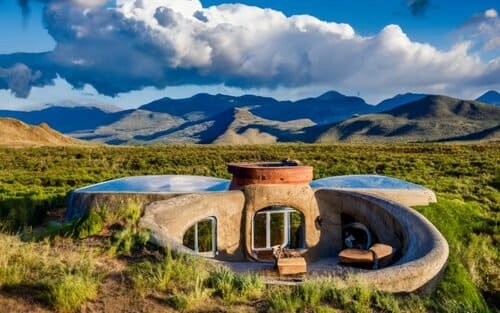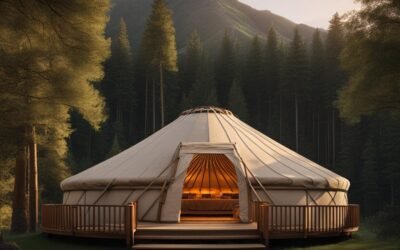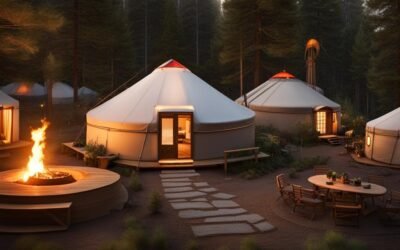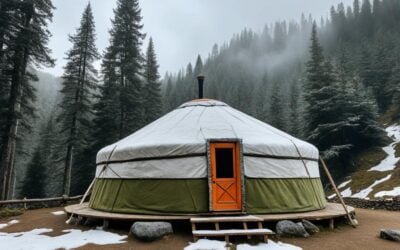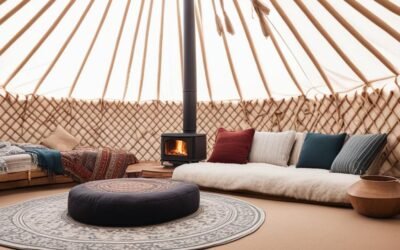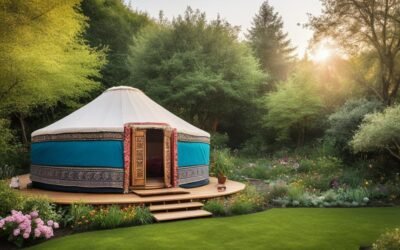Living in a yurt full time offers a unique and sustainable lifestyle. If you’re looking to embrace off-grid living and reap the benefits of a minimalist approach to life, then living in a yurt may be the perfect choice for you. In this guide, I’ll provide you with valuable insights from individuals who have experienced full-time yurt living, giving you the information you need to make an informed decision about this alternative living arrangement.
Key Takeaways:
- Living in a yurt full time allows for a unique and sustainable lifestyle.
- Embracing off-grid living in a yurt provides the opportunity to reduce your environmental footprint.
- Living in a yurt offers the benefits of a closer connection with nature.
- Consider the tips and insights shared by experienced yurt dwellers when making the decision to live in a yurt full time.
- By living in a yurt, you can create a space that aligns with your values and goals.
Choosing a Yurt as a Home
When considering yurt living as a permanent home, it’s crucial to take several factors into account. Sustainable living in a yurt entails making conscious decisions about materials, energy sources, and waste management. The yurt lifestyle promotes a minimalist mindset and fosters a deep connection with nature. Here are some essential tips and considerations for a fulfilling yurt living experience:
1. Insulation for Comfort and Energy Efficiency
Proper insulation plays a vital role in maintaining a comfortable living environment and reducing energy consumption. By using high-quality insulation materials, such as wool or recycled denim, you can regulate the temperature inside your yurt effectively.
2. Plumbing and Waste Management
Implementing an efficient plumbing system and waste management strategy is crucial for sustainable and convenient yurt living. Consider installing a composting toilet and a greywater system to minimize water usage and promote eco-friendly waste disposal.
3. Heating and Ventilation Systems
Ensure your yurt has appropriate heating and ventilation systems in place to maintain a comfortable indoor climate throughout the year. Wood-burning stoves or radiant floor heating can provide warmth during colder months, while strategically placed windows and vents help with proper airflow and ventilation.
4. Embrace a Minimalist Lifestyle
Living in a yurt often inspires a minimalist way of life. Embrace simplicity by decluttering and prioritizing essential items. Opt for multifunctional furniture or compact storage solutions to maximize space utilization within the yurt.
5. Harness Renewable Energy Sources
Make the most of sustainable energy sources to power your yurt. Installing solar panels or a small wind turbine can provide you with clean and renewable electricity, reducing your reliance on traditional power grids.
By considering these yurt living essentials and implementing sustainable practices, you can create a cozy, eco-friendly home that aligns with your values and allows you to fully embrace the yurt lifestyle.

Building and Setting Up Your Yurt
Building and setting up your yurt is an exciting process that requires careful planning and consideration. Whether you’re a DIY enthusiast or hiring professionals, it’s crucial to research and understand your local building codes and regulations before embarking on the construction journey. By following these steps, you can ensure a smooth and successful yurt living experience:
Step 1: Selecting the Right Location
Choose a suitable location for your yurt that complements your lifestyle and aligns with any zoning regulations. Consider factors such as access to utilities, sunlight exposure, and the surrounding natural landscape.
Step 2: Choosing the Size and Materials
Selecting the appropriate size for your yurt is essential. Take into account the number of occupants and your desired living space. Additionally, consider the materials for the yurt frame, cover, and insulation. Opt for high-quality materials to ensure durability and longevity.
Step 3: Setting Up the Foundation
The foundation of your yurt provides stability and support. Depending on your location and preferences, you can choose between options such as a traditional wooden platform, a concrete pad, or a raised deck. Each option has its advantages and considerations.
Step 4: Erecting the Yurt
Follow the manufacturer’s instructions or consult professionals to assemble and erect your yurt. This process involves connecting the lattice wall sections, securing the roof structure, and installing the cover. Ensure each step is performed meticulously to guarantee a secure and watertight structure.
Step 5: Adding the Finishing Touches
Once the yurt is erected, it’s time to add the finishing touches to make it feel like home. This can include insulation, interior design elements, furnishings, and utilities. Aim for a balance between functionality, comfort, and aesthetic appeal.
Building your yurt can be a rewarding experience, providing a sense of accomplishment and the opportunity to bring your vision to life. However, it’s important to note that the cost of building a yurt can vary depending on factors such as size, materials, and additional features. Conduct thorough research and budgeting to ensure a realistic and financially feasible project.
Joining yurt living communities can be highly beneficial during the building process. These communities offer support, resources, and a sense of camaraderie, allowing you to connect with like-minded individuals who share your passion for yurt living. Through these communities, you can gain valuable insights, learn from others’ experiences, and foster meaningful connections.

Embracing Off-Grid Living in a Yurt
Living off-grid in a yurt offers a multitude of benefits for those seeking a sustainable and self-sufficient lifestyle. By reducing our environmental footprint and embracing alternative methods of living, we can experience a closer connection with nature and enjoy the freedom to live in various locations.
One of the key advantages of off-grid yurt living is the ability to generate renewable energy. By installing solar panels or wind turbines, individuals can harness clean and sustainable power to meet their electricity needs. This not only reduces reliance on fossil fuels but also lowers utility costs, making off-grid living in a yurt a financially viable option.
“Living off-grid in a yurt allows me to live in harmony with nature while minimizing my impact on the environment. I generate my own electricity and feel a sense of accomplishment knowing that I am reducing my carbon footprint.”
Another important aspect of off-grid yurt living is the opportunity to collect rainwater. By setting up a rainwater harvesting system, individuals can ensure a reliable and sustainable water source. This not only saves water resources but also reduces dependency on traditional water supply systems. Utilizing composting toilets further contributes to a more eco-friendly lifestyle by minimizing water usage and promoting nutrient-rich soil.
Living in a yurt also fosters a closer connection with nature. The circular design and open floor plan allow for abundant natural light and unobstructed views of the surrounding environment. Waking up to breathtaking landscapes and being immersed in the sights and sounds of nature can have a positive impact on mental well-being and overall happiness.
The Benefits of Living in a Yurt
1. Lower utility costs: Off-grid living in a yurt eliminates or significantly reduces monthly utility bills, providing long-term financial savings.
2. Sustainable lifestyle: By generating renewable energy, conserving water, and utilizing composting toilets, individuals can live in a more environmentally friendly and self-sufficient manner.
3. Freedom to live in various locations: Yurts can be easily dismantled and transported, allowing for a nomadic lifestyle and the freedom to explore different landscapes and communities.
| Benefit | Description |
|---|---|
| 1. Lower utility costs | Eliminate or significantly reduce monthly utility bills by living off-grid in a yurt. |
| 2. Sustainable lifestyle | Reduce your environmental footprint and live a more self-sufficient lifestyle by generating renewable energy, conserving water, and utilizing composting toilets. |
| 3. Freedom to live in various locations | Enjoy the flexibility and adventure of living in different locations as yurts can be easily transported and set up. |
Living off-grid in a yurt allows individuals to embrace a sustainable and unique lifestyle that promotes self-sufficiency and harmony with nature. By reducing reliance on traditional utilities and embracing renewable energy, individuals can enjoy financial savings, a closer connection with the natural world, and the freedom to live on their terms.

Conclusion
Living in a yurt full time offers a unique and fulfilling experience that combines the sense of freedom with a sustainable lifestyle. By embracing the tips and insights from those who have lived in yurts, individuals can make informed choices about their living arrangements, creating a space that aligns with their values and goals.
Yurt living provides an opportunity to connect with nature and minimize the environmental footprint. It allows individuals to live off-grid, reducing utility costs and embracing self-sufficiency through renewable energy, rainwater collection, and composting toilets. This holistic approach to living fosters a closer relationship with nature and a more minimalistic mindset.
Building a yurt home and setting it up requires careful planning and consideration. It’s essential to research local building codes and regulations to ensure compliance. Additionally, exploring yurt living communities can provide valuable resources, support, and a welcoming community of like-minded individuals embarking on this lifestyle journey.
Whether you’re seeking a change or looking to live more sustainably, yurt living can be a transformative adventure. With its unique experiences, a strong connection to nature, and the opportunity to build a sense of community, living in a yurt full time offers an alternative and rewarding way of life.
FAQ
What are the benefits of living in a yurt full time?
Living in a yurt full time offers a unique and sustainable lifestyle. It allows individuals to embrace off-grid living, reduce their environmental footprint, lower utility costs, and have a closer connection with nature.
How do I choose a yurt as a home?
When choosing a yurt as a home, consider factors such as sustainable living practices, insulation, plumbing, heating, and ventilation systems. Embrace a minimalist mindset and a strong connection with nature to fully embrace the yurt lifestyle.
What should I consider when building and setting up a yurt?
It’s essential to research and understand local building codes and regulations before starting the construction process. Additionally, consider the cost, size, materials, and additional features of the yurt. Joining yurt living communities can provide support, resources, and a sense of community during this process.
What are the advantages of off-grid living in a yurt?
Off-grid living in a yurt allows individuals to live a more self-sufficient lifestyle by generating renewable energy, collecting rainwater, and utilizing composting toilets. It offers the freedom to choose various locations and reduces reliance on traditional utilities.
How does full-time yurt living provide unique experiences?
Full-time yurt living offers the adventure of living in a sustainable and unconventional home. It provides a sense of freedom, a closer connection with nature, and the opportunity to live in different locations without sacrificing comfort and functionality.




